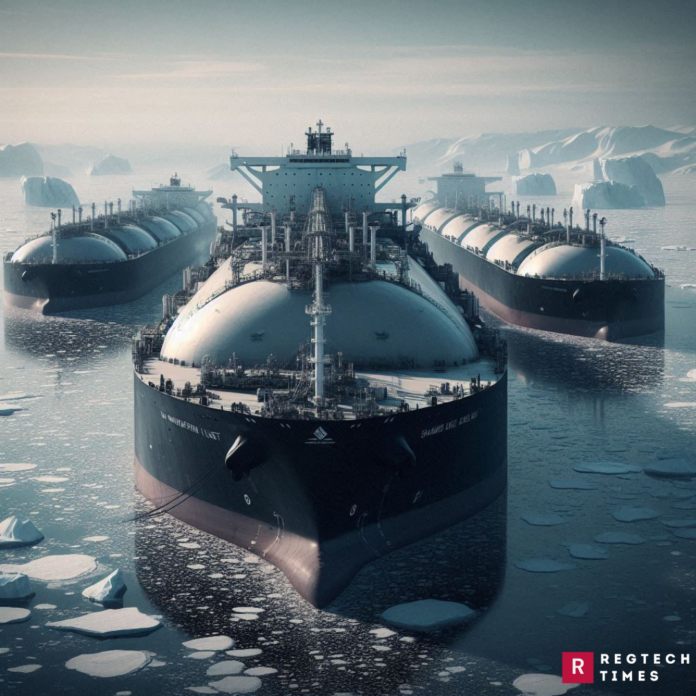The U.S. government has recently taken a significant step by imposing strict sanctions on seven liquefied natural gas (LNG) carriers connected to Russia. This move comes as part of the ongoing efforts to curb Russia’s influence in global energy markets, particularly after the country launched its newest export facility in the Arctic region. Among the targeted vessels are Pioneer and Asya Energy, which were believed to have loaded the first two shipments from the Arctic LNG 2 project, a facility that had already been sanctioned by the U.S. government.
The Arctic LNG 2 Project and Its Challenges
Arctic LNG 2, a massive project developed by Russia to export natural gas, has faced numerous challenges due to international sanctions. The U.S. initially imposed sanctions on the facility late last year, significantly delaying the start of its exports. These sanctions were aimed at discouraging foreign companies from participating in the project and preventing the delivery of specialized ice-ready carriers that are crucial for transporting LNG from the Arctic region. Despite these obstacles, Russia managed to find a way around these restrictions by assembling a shadow fleet of tankers.
The shadow fleet is composed of vessels with opaque ownership and unknown insurers, often deploying tactics like turning off or manipulating their automatic identification systems to hide their locations. This allows them to operate under the radar, making it difficult for authorities to track their movements. Satellite images recently revealed that two shipments were loaded at the Arctic LNG 2 facility onto the Pioneer and Asya Energy vessels. These ships are currently at sea, with the Pioneer positioned north of the Suez Canal in the Mediterranean and the Asya Energy located offshore Norway. The identities of the buyers of these cargoes remain unknown, further complicating the situation.
Defying US Sanctions: How Russia is Evading Restrictions to Expand Arctic LNG 2
Swift Action by the U.S. Government
The U.S. Department of the Treasury’s decision to sanction these LNG vessels, including the Pioneer and Asya Energy, underscores the speed and determination with which the U.S. is acting against Russia. The first suspected cargo from Arctic LNG 2 was loaded less than a month ago, making the sanctions a rapid response by the U.S. government. This action is seen as a significant blow to Russia, which has spent months developing its shadow fleet to circumvent international sanctions.
In addition to the LNG vessels, the U.S. also targeted other shipping and technical companies related to the sanctioned vessels. Among them are Ocean Speedstar Solutions, an India-based owner, and White Fox Ship Management, a company based in Dubai. Both of these entities have been linked to the newly-sanctioned LNG carriers. The inclusion of these companies in the sanctions list further demonstrates the U.S. government’s commitment to disrupting Russia’s LNG operations.
Cargo Ship at Arctic LNG 2 Terminal: A Bold Move in Russia’s Sanctions-Evasion Playbook
Another vessel, Everest Energy, which is suspected to be part of Russia’s “dark fleet” of tankers, has also been added to the list of sanctioned entities. The dark fleet is believed to be a group of vessels assembled by Moscow to transport gas to willing buyers, despite the international sanctions in place. The addition of Everest Energy to the sanctions list signals that the U.S. is closely monitoring and acting against any attempts by Russia to bypass these restrictions.
Widespread Impact on Russian Energy Supply Chain
The sanctions imposed by the U.S., along with those by the European Union (EU) and the United Kingdom (U.K.), have had a profound impact on Russia’s energy supply chain. Since late last year, dozens of tankers tied to the Russian oil trade have been sanctioned by these authorities. While the measures have not significantly disrupted freight markets or the flow of Russian petroleum, they have led to the idling of many vessels, complicating Moscow’s logistics for transporting energy.
Aircraft Carrier Wrecked: US Sanctions Cripple Russia’s Naval Power
In addition to the Arctic LNG 2 project, the U.S. sanctions also extend to other vessels that have been involved in moving cargoes from Russia’s Yamal LNG plant. Four vessels—North Sky, North Mountain, North Air, and North Way—have been sanctioned as part of this broader effort. These vessels have been known to stop in Zeebrugge, Belgium, to pick up loads from specialized ice-class vessels. This practice will be banned from March 2025 under the EU’s sanctions, adding another layer of difficulty for Russia’s LNG operations.
The impact of these sanctions is far-reaching, affecting not only the vessels and companies directly involved but also the broader Russian energy sector. Novatek PJSC, the majority shareholder of both the Arctic LNG 2 and Yamal LNG plants, has seen its China-based unit included in the list of sanctioned entities. The U.S. government’s actions send a clear message that it is not only targeting the facilities themselves but also the shipments and associated companies.
This decisive action by the U.S. represents a significant step in its efforts to curb Russia’s influence in the global LNG market. The swift imposition of sanctions on the vessels and companies involved in the Arctic LNG 2 project highlights the seriousness with which the U.S. is approaching this issue. As the situation continues to develop, it remains to be seen how Russia will respond to these latest challenges to its energy ambitions.


